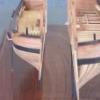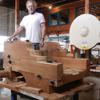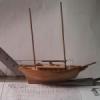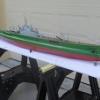-
Posts
3,349 -
Joined
-
Last visited
Reputation Activity
-
 Cathead got a reaction from dgbot in Steamboats and other rivercraft - general discussion
Cathead got a reaction from dgbot in Steamboats and other rivercraft - general discussion
American riverboats weren't confined to the major rivers; there were many smaller, obscure craft that worked the tributaries. In my home state of Missouri, several rivers feeding the large Missouri River were themselves large enough to support steamboat traffic deep into the Ozark Hills, such as the Gasconade and Osage rivers.
This page from the Miller County Museum & Historical Society, in central-south Missouri, has a series of interesting photographs of small steamboats that worked the Osage River. One of these little boats seems like an interesting scratchbuild project to me someday, particularly the J.R. Wells which I find quite attractive. Adding to the interest, the Wells and several other boats were actually built in Miller County, not in the major steamboat yards along the faraway Upper Ohio, making them truly indigenous boats.
There's also a great story about the first steamboat to penetrate the remote Ozark region:
I think some of you would enjoy reading this page and looking at the images of obscure but interesting steamboats from Missouri.
-
 Cathead got a reaction from mattsayers148 in 18th Century Longboat by Cathead - FINISHED - Model Shipways - 1:48
Cathead got a reaction from mattsayers148 in 18th Century Longboat by Cathead - FINISHED - Model Shipways - 1:48
And here she is with the jib. I couldn't find a clear reference for how to shape each sail, so I defaulted to the size & shape they've have if they hung limp within the rigging (as shown on my drawings). I don't know if the jib is actually supposed to be larger than the stay sail, but correct or not, I'm pleased with the outcome from a visual display perspective.
The jib is hooked to the bowsprit traveller, allowing it to be hauled out, with a halyard run through a block on the mast just like the stay sail. Seems like it would work in real life.
Now it's on to the standing rigging.
-
 Cathead got a reaction from slow2cool in Heroine 1838 by ggrieco - FINISHED - Scale 1:24 - Western River Steamboat as she appeared before hitting a snag in the Red River
Cathead got a reaction from slow2cool in Heroine 1838 by ggrieco - FINISHED - Scale 1:24 - Western River Steamboat as she appeared before hitting a snag in the Red River
Wow, fascinating question. I'm afraid I'll no help this time, I have no idea.
-
 Cathead got a reaction from Canute in Heroine 1838 by ggrieco - FINISHED - Scale 1:24 - Western River Steamboat as she appeared before hitting a snag in the Red River
Cathead got a reaction from Canute in Heroine 1838 by ggrieco - FINISHED - Scale 1:24 - Western River Steamboat as she appeared before hitting a snag in the Red River
Wow, fascinating question. I'm afraid I'll no help this time, I have no idea.
-
 Cathead got a reaction from Canute in Steamboats and other rivercraft - general discussion
Cathead got a reaction from Canute in Steamboats and other rivercraft - general discussion
Bob, I don't, but that historical society/museum is only a few hours from me, so if I ever decide to pursue the idea, it's within reach. I assume I won't ever find plans or such, it was probably built without them, but ideally I'd be able to find other photos or written accounts of its use, engine, etc.
-
 Cathead reacted to GuntherMT in 18th Century Longboat by Cathead - FINISHED - Model Shipways - 1:48
Cathead reacted to GuntherMT in 18th Century Longboat by Cathead - FINISHED - Model Shipways - 1:48
The sails look great, to my eye you pretty much nailed it!
-
 Cathead reacted to ggrieco in Heroine 1838 by ggrieco - FINISHED - Scale 1:24 - Western River Steamboat as she appeared before hitting a snag in the Red River
Cathead reacted to ggrieco in Heroine 1838 by ggrieco - FINISHED - Scale 1:24 - Western River Steamboat as she appeared before hitting a snag in the Red River
Thanks chborgm, druxey, Carl, Kees and Tom. I really appreciate your kind comments and advice.
I was hoping I could get some advice on color. I'm not color blind, just color ignorant. Most of my models are just oiled and if I do use paint it is usually just black. I was hoping someone could give me an idea for an appropriate white that would have been used on boats in the early 19th century. For black I always use Ronan Japan colors and was wondering if one of their whites might have the correct appearance. I am totally at a loss when it comes to color and any help you could offer would be greatly appreciated.
-
 Cathead got a reaction from yvesvidal in Gokstad Viking Ship by jack.aubrey - FINISHED - Dusek Ship Kits - 1:35 Scale
Cathead got a reaction from yvesvidal in Gokstad Viking Ship by jack.aubrey - FINISHED - Dusek Ship Kits - 1:35 Scale
The sage is beautiful, but what ship modellers really need is more thyme. Lovely model.
-
 Cathead got a reaction from ggrieco in 18th Century Longboat by Cathead - FINISHED - Model Shipways - 1:48
Cathead got a reaction from ggrieco in 18th Century Longboat by Cathead - FINISHED - Model Shipways - 1:48
And here she is with the jib. I couldn't find a clear reference for how to shape each sail, so I defaulted to the size & shape they've have if they hung limp within the rigging (as shown on my drawings). I don't know if the jib is actually supposed to be larger than the stay sail, but correct or not, I'm pleased with the outcome from a visual display perspective.
The jib is hooked to the bowsprit traveller, allowing it to be hauled out, with a halyard run through a block on the mast just like the stay sail. Seems like it would work in real life.
Now it's on to the standing rigging.
-
 Cathead got a reaction from mtaylor in Steamboats and other rivercraft - general discussion
Cathead got a reaction from mtaylor in Steamboats and other rivercraft - general discussion
Bob, I don't, but that historical society/museum is only a few hours from me, so if I ever decide to pursue the idea, it's within reach. I assume I won't ever find plans or such, it was probably built without them, but ideally I'd be able to find other photos or written accounts of its use, engine, etc.
-
 Cathead got a reaction from Canute in Steamboats and other rivercraft - general discussion
Cathead got a reaction from Canute in Steamboats and other rivercraft - general discussion
American riverboats weren't confined to the major rivers; there were many smaller, obscure craft that worked the tributaries. In my home state of Missouri, several rivers feeding the large Missouri River were themselves large enough to support steamboat traffic deep into the Ozark Hills, such as the Gasconade and Osage rivers.
This page from the Miller County Museum & Historical Society, in central-south Missouri, has a series of interesting photographs of small steamboats that worked the Osage River. One of these little boats seems like an interesting scratchbuild project to me someday, particularly the J.R. Wells which I find quite attractive. Adding to the interest, the Wells and several other boats were actually built in Miller County, not in the major steamboat yards along the faraway Upper Ohio, making them truly indigenous boats.
There's also a great story about the first steamboat to penetrate the remote Ozark region:
I think some of you would enjoy reading this page and looking at the images of obscure but interesting steamboats from Missouri.
-
 Cathead got a reaction from Altduck in 18th Century Longboat by Cathead - FINISHED - Model Shipways - 1:48
Cathead got a reaction from Altduck in 18th Century Longboat by Cathead - FINISHED - Model Shipways - 1:48
And here she is with the jib. I couldn't find a clear reference for how to shape each sail, so I defaulted to the size & shape they've have if they hung limp within the rigging (as shown on my drawings). I don't know if the jib is actually supposed to be larger than the stay sail, but correct or not, I'm pleased with the outcome from a visual display perspective.
The jib is hooked to the bowsprit traveller, allowing it to be hauled out, with a halyard run through a block on the mast just like the stay sail. Seems like it would work in real life.
Now it's on to the standing rigging.
-
 Cathead got a reaction from cog in Heroine 1838 by ggrieco - FINISHED - Scale 1:24 - Western River Steamboat as she appeared before hitting a snag in the Red River
Cathead got a reaction from cog in Heroine 1838 by ggrieco - FINISHED - Scale 1:24 - Western River Steamboat as she appeared before hitting a snag in the Red River
Glenn,
Louis C. Hunter's Steamboats on the Western Rivers discusses to the superior maneuverability of side-wheelers over sternwheelers, in part, by referring to "The ability to stop one of the wheels independently of the other and, on two-engine boats, to run the two paddle wheels in opposite directions..." which implies what you suggest, that wheels can be stopped while in motion but not re-engaged. Also, obviously, Heroine couldn't have run her wheels in opposing fashion unlike later boats, so some of the turning ability is negated. Certainly, this makes mechanical sense to me, I don't see any way you could safely or practically slip that clutch into place while the shaft is turning, especially with water pressure holding the wheel in place. And the implicit reference to single-engine boats strongly implies that this all applies to Heroine, since two-engine boats became the standard not long after her time.
-
 Cathead got a reaction from Gerhardvienna in Steamboats and other rivercraft - general discussion
Cathead got a reaction from Gerhardvienna in Steamboats and other rivercraft - general discussion
American riverboats weren't confined to the major rivers; there were many smaller, obscure craft that worked the tributaries. In my home state of Missouri, several rivers feeding the large Missouri River were themselves large enough to support steamboat traffic deep into the Ozark Hills, such as the Gasconade and Osage rivers.
This page from the Miller County Museum & Historical Society, in central-south Missouri, has a series of interesting photographs of small steamboats that worked the Osage River. One of these little boats seems like an interesting scratchbuild project to me someday, particularly the J.R. Wells which I find quite attractive. Adding to the interest, the Wells and several other boats were actually built in Miller County, not in the major steamboat yards along the faraway Upper Ohio, making them truly indigenous boats.
There's also a great story about the first steamboat to penetrate the remote Ozark region:
I think some of you would enjoy reading this page and looking at the images of obscure but interesting steamboats from Missouri.
-
 Cathead got a reaction from slow2cool in Heroine 1838 by ggrieco - FINISHED - Scale 1:24 - Western River Steamboat as she appeared before hitting a snag in the Red River
Cathead got a reaction from slow2cool in Heroine 1838 by ggrieco - FINISHED - Scale 1:24 - Western River Steamboat as she appeared before hitting a snag in the Red River
Glenn,
Louis C. Hunter's Steamboats on the Western Rivers discusses to the superior maneuverability of side-wheelers over sternwheelers, in part, by referring to "The ability to stop one of the wheels independently of the other and, on two-engine boats, to run the two paddle wheels in opposite directions..." which implies what you suggest, that wheels can be stopped while in motion but not re-engaged. Also, obviously, Heroine couldn't have run her wheels in opposing fashion unlike later boats, so some of the turning ability is negated. Certainly, this makes mechanical sense to me, I don't see any way you could safely or practically slip that clutch into place while the shaft is turning, especially with water pressure holding the wheel in place. And the implicit reference to single-engine boats strongly implies that this all applies to Heroine, since two-engine boats became the standard not long after her time.
-
 Cathead got a reaction from Canute in Heroine 1838 by ggrieco - FINISHED - Scale 1:24 - Western River Steamboat as she appeared before hitting a snag in the Red River
Cathead got a reaction from Canute in Heroine 1838 by ggrieco - FINISHED - Scale 1:24 - Western River Steamboat as she appeared before hitting a snag in the Red River
Glenn,
Louis C. Hunter's Steamboats on the Western Rivers discusses to the superior maneuverability of side-wheelers over sternwheelers, in part, by referring to "The ability to stop one of the wheels independently of the other and, on two-engine boats, to run the two paddle wheels in opposite directions..." which implies what you suggest, that wheels can be stopped while in motion but not re-engaged. Also, obviously, Heroine couldn't have run her wheels in opposing fashion unlike later boats, so some of the turning ability is negated. Certainly, this makes mechanical sense to me, I don't see any way you could safely or practically slip that clutch into place while the shaft is turning, especially with water pressure holding the wheel in place. And the implicit reference to single-engine boats strongly implies that this all applies to Heroine, since two-engine boats became the standard not long after her time.
-
 Cathead got a reaction from Piet in Licorne 1755 by mtaylor - 3/16" scale - French Frigate - from Hahn plans - Version 2.0 - TERMINATED
Cathead got a reaction from Piet in Licorne 1755 by mtaylor - 3/16" scale - French Frigate - from Hahn plans - Version 2.0 - TERMINATED
Thanks for the nice explanation of that 3D shaping, something I've never done before.
-
 Cathead got a reaction from mattsayers148 in 18th Century Longboat by Cathead - FINISHED - Model Shipways - 1:48
Cathead got a reaction from mattsayers148 in 18th Century Longboat by Cathead - FINISHED - Model Shipways - 1:48
So I mocked up examples of four possible paint schemes, partly to get Mrs. Cathead's input since she'll have to look at the finished version, and partly to see if any of you had input.
A. is essentially the kit plan, with a black stripe replacing the friezes.
B. is the "Victory yawl" pattern I've found various photos of, using a black stripe and stained-wood cap rail and moulding strip.
C. is an all-wood version using either a black or white stripe replacing the friezes
D. is A but with stained wood replacing red on the cap rail.
There are a few alternate rudder possibilities as well.
I know which one I favor personally, but are there reasons for or against any of these, whether authenticity, feasibility, or other?
Finally, I've never done treenails before. Is it worth doing them in areas that would be painted (like below the waterline)? Would they show through the paint on the real thing?
-
 Cathead got a reaction from Canute in Steamboats and other rivercraft - general discussion
Cathead got a reaction from Canute in Steamboats and other rivercraft - general discussion
Great point, Bob. That's been on my travel list ever since Kurt mentioned it to me. It's just far enough away from me to make it difficult.
-
 Cathead got a reaction from Canute in 18th Century Longboat by Cathead - FINISHED - Model Shipways - 1:48
Cathead got a reaction from Canute in 18th Century Longboat by Cathead - FINISHED - Model Shipways - 1:48
And here she is with the jib. I couldn't find a clear reference for how to shape each sail, so I defaulted to the size & shape they've have if they hung limp within the rigging (as shown on my drawings). I don't know if the jib is actually supposed to be larger than the stay sail, but correct or not, I'm pleased with the outcome from a visual display perspective.
The jib is hooked to the bowsprit traveller, allowing it to be hauled out, with a halyard run through a block on the mast just like the stay sail. Seems like it would work in real life.
Now it's on to the standing rigging.
-
 Cathead got a reaction from catopower in To help kit developers and kit builders alike-What would you like to see developed for the hobby.
Cathead got a reaction from catopower in To help kit developers and kit builders alike-What would you like to see developed for the hobby.
What's important to understand is that someone saying "I want this awesome thing made out of the best possible components which are all expensive, but I want it to cost a dollar" isn't necessarily insisting that all three of those things be true all the time, they're just telling you that those three things are important to them, just as a market customer is telling me that they care about cost, quality, and growing method.
It's not breaking news, but this collection of comments tells us that majority of people here like 17-18th ocean-going ships, they have a budget they feel is appropriate, and they value good materials and instructions. Any given designer may not be able to meet all three goals, but they can make an educated decision about which of them to focus on.
Again, this thread asked people what they thought in general, as if I handed out a survey of farmers market shoppers. People giving their ideal ideas to a survey is not the same as people specifically criticizing a given vendor. Consumers that challenge my market prices directly and personally are annoying if they don't try to understand the business model. Consumers who tell a survey that they want organic, affordable, nice-looking produce are just telling me in general what's important to them. Respondents to this thread are, by and large, saying what matters to them in general; they're not saying "X company is too expensive or Y company doesn't make models I like".
For example, when I say I want a kit to be $250-$400, I'm saying that's as much as I can possibly justify spending. If the only way to make a kit I'd otherwise like is for it to be $600, then I don't want that kit made for me because I won't be able to buy it no matter how nice it is. That's important information for a manufacturer. I'm not insisting they lose money making me a $600 kit for $400, I'm saying that's my budgetary limit, period. We chose not to grow some things on our farm because we couldn't sell them at a price consumers would accept. I'd like to grow them, but I accept that people won't pay me to do so. They can grow them in their home garden if they want those items, or scratchbuild that model, or just do without if that's what life dictates. Again, don't misinterpret what's being said in this forum.
-
 Cathead got a reaction from muzzleloader in To help kit developers and kit builders alike-What would you like to see developed for the hobby.
Cathead got a reaction from muzzleloader in To help kit developers and kit builders alike-What would you like to see developed for the hobby.
People aren't being unreasonable, they're doing exactly what they were asked to do by the topic, sharing what they'd like to see. Most of us don't know anything about the business side of kit development (which is why I tried to ask about it earlier), so how do you expect respondents to magically produce only practical answers?
Look, no one understands businesses they aren't engaged in. Among other things, I'm a vegetable farmer, and farmers market customers always want their produce organic, perfect, and cheap. Well, you can't have all three. Organic and perfect, it won't be cheap. Organic and cheap, it's going to have bug damage. Perfect and cheap, it ain't going to be chemical-free. But people who have never grown a vegetable in their life, or even people who have a home garden, have no mental structure for evaluating the actual business of vegetable production.
So there's no need to get huffy about modellers saying what they'd "like" to see, especially when that's what was asked for. If we can get a nice explanation from the developers of what actually goes into the business model of kit development, maybe then we can give more "realistic" answers. Until then, just take the feedback here at face value as a narrow sampling of a limited community of dedicated modellers and get what value you can from it.
-
 Cathead got a reaction from EricWilliamMarshall in 18th Century Longboat by Cathead - FINISHED - Model Shipways - 1:48
Cathead got a reaction from EricWilliamMarshall in 18th Century Longboat by Cathead - FINISHED - Model Shipways - 1:48
I've been experimenting with sail-making (special thanks to samueljr, who PMed me to offer advice). I tried three materials: sail cloth, basic index-card cardstock, and nice bond paper (conveniently left over from Mrs. Cathead's graduate thesis many years ago). I made a pattern from tracing paper, and used that to make equivalent sails from all these materials.
For all three materials, I followed several similar steps:
Cut out core sail shape from intended material. Cut, score, & fold paper strips to serve as edge reinforcements (even for the cloth sail, as I was quickly convinced I couldn't sew hems or seams remotely to scale for this model). Make corner rope loops by clamping a folded-over length of rigging line in a clothespin, twisting the two ends until they tightened up into the right-size loop, securing the twist with another clothespin, then applying CA to the twist. When dry, I cut most of the tail end off and had a nice stable loop with enough tail to hold it within the sail's hem. Glue rope loops into pre-cut paper strips, along the creased center line. Spread wood glue thinly along the interior of each paper strip, then fold over the sail and clamp tight with a series of clothespins. I also tested coloration, using artist's pastels that have long been a staple of my weathering toolkit for models. Both paper and cloth take pastels nicely without need for adhesives. In the photo below, you see three completed tests; all-cardstock (top), cloth with cardstock hems (lower right), and bond paper with cardstock hems (lower left).
I overcolored the cloth sail to get a sense of when to stop, and tested two different lighter colorations on the paper sails. I had already been convinced I didn't want to use cloth sails, the materials didn't play well together, the sail was too floppy, and the weave too coarse. I also tested a bond paper sail with bond paper hem, but found that the material was too soft to hold well as a hem; it crumpled with the moisture of the glue and didn't stiffen the sail well. The cardstock hems worked great, really stiffening the sail and allowing me to impart a nice curve to it without needing to treat the whole sail.
I liked the bond paper sail best, the finer quality of the paper made a nice sail, while the cardstock hem didn't stand out as different while being much stiffer and easier to work with. I carefully traced stitching onto all of these with a ruler and pencil to check how detail would stand out. I learned that it's best not to do the pencil work until you're otherwise done, as it can smudge as you adjust the pastels or otherwise handle the sail. In every way I liked the sail at lower left best (bond paper with cardstock hem and very light weathering/coloration); here's a closer look:
Satisfied with this attempt, I decided to see how it looked on the model. Here it is, fully rigged but not permanently. Most lines are still loose, held in tension by a series of clamps hanging from the lines (hidden behind the model).
What do you all think? Now's the time for me to make changes or try a different approach, before I rig the mailsail permanently and move on to the stay sail and jib (note that there's still a temporary line run to the masthead from the bowsprit traveler, to help me shape the jib properly even though that line won't be there on the final model).
-
 Cathead got a reaction from Ryland Craze in 18th Century Longboat by Cathead - FINISHED - Model Shipways - 1:48
Cathead got a reaction from Ryland Craze in 18th Century Longboat by Cathead - FINISHED - Model Shipways - 1:48
And here she is with the jib. I couldn't find a clear reference for how to shape each sail, so I defaulted to the size & shape they've have if they hung limp within the rigging (as shown on my drawings). I don't know if the jib is actually supposed to be larger than the stay sail, but correct or not, I'm pleased with the outcome from a visual display perspective.
The jib is hooked to the bowsprit traveller, allowing it to be hauled out, with a halyard run through a block on the mast just like the stay sail. Seems like it would work in real life.
Now it's on to the standing rigging.
-
 Cathead got a reaction from EricWilliamMarshall in 18th Century Longboat by Cathead - FINISHED - Model Shipways - 1:48
Cathead got a reaction from EricWilliamMarshall in 18th Century Longboat by Cathead - FINISHED - Model Shipways - 1:48
Stay sail is rigged:
For the halyard, I rigged a single block at the mast rather than pass the line through the mast sheave. It made the rigging easier to handle, rather than tangling it with the other lines behind the mast (this also seems more functional for the real-life craft as well). The tack is hooked to a ring bolt at the bow. The sheet is belayed to a pin. The sail ends up looking smaller than I expected, I think because I measured it hanging dead from the stay, rather than billowed out, but I think the jib will balance it nicely.
You may have noticed the missing bowsprit. I broke that off with an errant wrist while rigging the stay sail. Turned out to be a blessing in disguise, as the reason I bumped it was that it was really in the way in the first place. I just left it off until I was done with the staysail. Fortunately, it came off cleanly and I think I can just glue it back on when I'm ready to work on the jib. It would have worked great to not even install the bowsprit until I'd finished the rigging to this point; something to keep in mind if I end up in a future situation on another build.
Anyway, I like the way it's shaping up. One more sail to go, then the final standing rigging.














.thumb.jpeg.fc5d633a7b34428fcf19419a73d56d55.jpeg)
